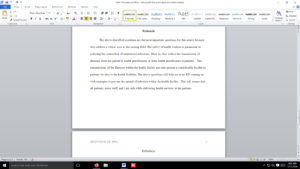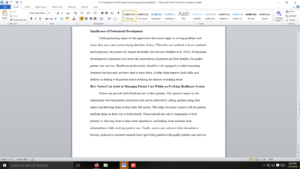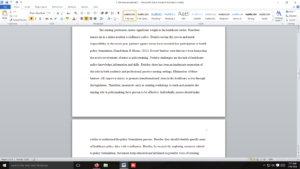As a baccalaureate-prepared nurse, your participation and leadership in interdisciplinary teams will be vital to the health outcomes for your patients and organization. One way to approach designing an improvement project is to use the Plan-Do-Study-Act (PDSA) cycle. The Institute for Healthcare Improvement describes it thus:
The Plan-Do-Study-Act (PDSA) cycle is shorthand for testing a change in the real work setting—by planning it, trying it, observing the results, and acting on what is learned. This is the scientific method adapted for action-oriented learning…Essentially, the PDSA cycle helps you test out change ideas on a smaller scale before evaluating the results and making adjustments before potentially launching into a somewhat larger scale project (n.d.).
You might also recognize that the PDSA cycle resembles the nursing process. The benefit of gaining experience with this model of project design is that it provides nurses with an opportunity to ideate and lead improvements. For this assessment, you will not be implementing all of the PDSA cycle. Instead, you are being asked to interview a health care professional of your choice to determine what kind of interdisciplinary problem he or she is experiencing or has experienced in the workplace. This interview, in Assessment 2, will inform the research that you will conduct to propose a plan for interdisciplinary collaboration in Assessment 3.
It would be an excellent choice to complete the PDSA Cycle activity prior to developing the report. The activity consists of four questions that create the opportunity to check your understanding of best-practices related to each stage of the PDSA cycle. The information gained from completing this formative will promote your success with the Interview and Interdisciplinary Issue Identification report. This will take just a few minutes of your time and is not graded.
Reference
Institute for Healthcare Improvement. (n.d.). How to improve. Retrieved from http://www.ihi.org/resources/Pages/HowtoImprove/de…
Demonstration of Proficiency
- Competency 2: Explain how interdisciplinary collaboration can be used to achieve desired patient and systems outcomes.
- Summarize an interview focused on past or current issues at a health care organization.
- Describe collaboration approaches from the literature that could be relevant in establishing or improving an interdisciplinary team to address an organizational issue.
- Competency 3: Describe ways to incorporate evidence-based practice within an interdisciplinary team.
- Identify an issue from an interview for which an evidence-based interdisciplinary approach would be appropriate.
- Competency 4: Explain how change management theories and leadership strategies can enable interdisciplinary teams to achieve specific organizational goals.
- Describe change theories and a leadership strategy that could help develop an interdisciplinary solution to an organizational issue.
- Competency 5: Apply professional, scholarly, evidence-based communication strategies to impact patient, interdisciplinary team, and systems outcomes.
- Organize content so ideas flow logically with smooth transitions; contains few errors in grammar/punctuation, word choice, and spelling.
- Apply APA formatting to in-text citations and references, exhibiting nearly flawless adherence to APA format.
Professional Context
This assessment will introduce the Plan-Do-Study-Act (PDSA) Model to create change in an organization. By interviewing a colleague of your choice, you will begin gathering information about an interprofessional collaboration problem that your colleague is experiencing or has experienced. You will identify a change theory and leadership strategies to help solve this problem.
Scenario
This assessment is the first of three related assessments in which you will gather interview information (Assessment 2); design a proposal for interdisciplinary problem-solving, (Assessment 3); and report on how an interdisciplinary improvement plan could be implemented in a place of practice (Assessment 4). At the end of the course, your interviewee will have a proposal plan based on the PDSA cycle that he or she could present to stakeholders to address an interdisciplinary problem in the workplace.
For this assessment, you will need to interview a health care professional such as a fellow learner, nursing colleague, administrator, business partner, or another appropriate person who could provide you with sufficient information regarding an organizational problem that he or she is experiencing or has experienced, or an area where they are seeking improvements. Consult the Interview Guide [DOCX] for an outline of how to prepare and the types of information you will need to complete this project successfully.
Remember: this is just the first in a series of three assessments.
Instructions
For this assessment, you will report on the information that you collected in your interview, analyzing the interview data and identifying a past or current issue that would benefit from an interdisciplinary approach. This could be an issue that has not been addressed by an interdisciplinary approach or one that could benefit from improvements related to the interdisciplinary approach currently being used. You will discuss the interview strategy that you used to collect information. Your interview strategy should be supported by citations from the literature. Additionally, you will start laying the foundation for your Interdisciplinary Plan Proposal (Assessment 3) by researching potential change theories, leadership strategies, and collaboration approaches that could be relevant to issue you have identified. Please be certain to review the scoring guide to confirm specific required elements of this assessment. Note that there are differences between basic, proficient and distinguished scores.
When submitting your plan, use the Interview and Issue Identification Template [DOCX], which will help you to stay organized and concise. As you complete the template, make sure you use APA format for in-text citations for the evidence and best practices that are informing your plan, as well as for the reference list at the end.
Additionally, be sure to address the following, which corresponds to the grading criteria in the scoring guide. Please study the scoring guide carefully so you understand what is needed for a distinguished score.
- Summarize an interview focused on past or current issues at a health care organization.
- Identify an issue from an interview for which an evidence-based interdisciplinary approach would be appropriate.
- Describe potential change theories and a leadership strategies that could inform an interdisciplinary solution to an organizational issue.
- Describe collaboration approaches from the literature that could facilitate establishing or improving an interdisciplinary team to address an organizational issue.
- Communicate with writing that is clear, logically organized, and professional, with correct grammar and spelling, and using current APA style.
Additional Requirements
- Length of submission: Use the provided template. Most submissions will be 2 to 4 pages in length. Be sure to include a reference page at the end of the plan.
- Number of references: Cite a minimum of 3 sources of scholarly or professional evidence that support your central ideas. Resources should be no more than 5 years old.
- APA formatting: Make sure that in-text citations and reference list follow current APA style.
Portfolio Prompt: Remember to save the final assessment to your ePortfolio so that you may refer to it as you complete the final Capstone course.
Requirements: 2-4 pages
Answer preview
Change Theories That Could Lead to an Interdisciplinary Solution
The Force Field Model and the Unfreezing-Change-Freezing Model are relevant theories that the change management team could apply in this scenario. The Force Field Model is explanatory in evaluating the change process and the factors that inhibit organizational change (Udod & Wagner, 2018). It asserts that the progress of change is determined by the proportion of driving forces and restraining forces. The Unfreezing-Change-Refreezing Model takes a more practical approach and identifies the three major steps needed to change. Unlearning old practices in the healthcare setup is akin to reducing the restraining forces to facilitate new mechanisms to increase the driving forces of change (Udod & Wagner, 2018). Ultimately it is essential to freeze the new practices so that they become established norms.
[911 Words]

Health care professional











